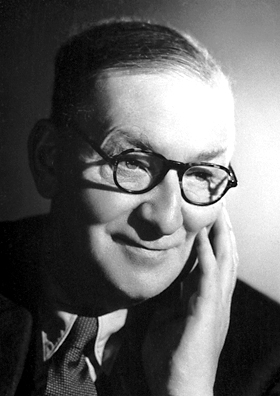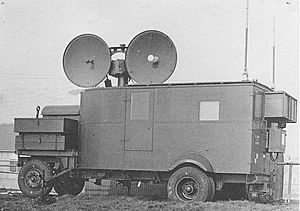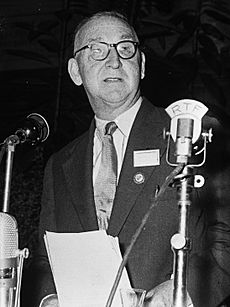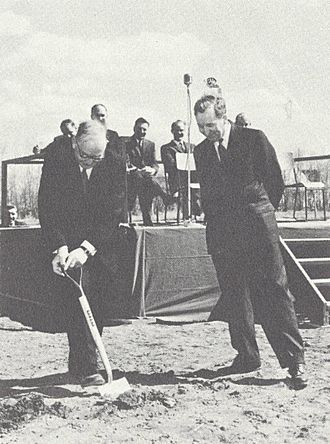John Cockcroft facts for kids
Quick facts for kids
Sir John Cockcroft
|
|
|---|---|

Cockcroft in 1951
|
|
| Born | 27 May 1897 Todmorden, West Riding of Yorkshire, England
|
| Died | 18 September 1967 (aged 70) Cambridge, Cambridgeshire, England
|
| Alma mater | Victoria University of Manchester Manchester Municipal College of Technology St. John's College, Cambridge |
| Known for | Splitting the atom |
| Awards |
|
| Scientific career | |
| Fields | Physics |
| Institutions | Atomic Energy Research Establishment |
| Thesis | On phenomena occurring in the condensation of molecular streams on surfaces (1928) |
| Academic advisors | Ernest Rutherford |
| 1st Master of Churchill College, Cambridge | |
| In office 1959–1967 |
|
| Succeeded by | Sir William Hawthorne |
Sir John Douglas Cockcroft (born May 27, 1897 – died September 18, 1967) was a British physicist. He won the Nobel Prize in Physics in 1951 with Ernest Walton. They won for being the first to split the atom. This was a huge step in understanding nuclear power.
After fighting in World War I as an artillery soldier, Cockcroft studied electrical engineering. He then earned a scholarship to St John's College, Cambridge. There, he became a research student under Ernest Rutherford, a famous physicist. With Ernest Walton, he built a special machine called a Cockcroft–Walton generator. They used this machine to break apart an atomic nucleus for the first time. This amazing achievement became known as splitting the atom.
During World War II, Cockcroft worked on radar technology. He also helped explore if an atomic bomb could be built. He shared British technology with the United States through the Tizard Mission. This helped both countries develop important tools like advanced radar and the proximity fuze. These were vital in defending against V-1 flying bombs. Later, he led the Montreal Laboratory in Canada. There, he oversaw the creation of early nuclear reactors like ZEEP and NRX.
After the war, Cockcroft became the director of the Atomic Energy Research Establishment (AERE) at Harwell. Under his leadership, the GLEEP reactor became the first to operate in Western Europe. He also insisted that the chimney stacks of the Windscale reactors have special filters. These filters, once called Cockcroft's Folly, later prevented a major disaster during the Windscale fire of 1957. From 1959 to 1967, he was the first head of Churchill College, Cambridge.
Contents
Early Life and Education
John Douglas Cockcroft was born on May 27, 1897, in Todmorden, England. He was the oldest of five brothers. He went to local schools and was good at sports like football and cricket. In 1914, he won a scholarship to study mathematics at the Victoria University of Manchester.
When World War I started in 1914, Cockcroft joined the British Army in 1915. He served on the Western Front as a signaller in the Royal Field Artillery. He fought in battles like the Third Battle of Ypres. In 1918, he became a lieutenant.
After the war, in 1919, Cockcroft left the army. He decided to study electrical engineering at Manchester Municipal College of Technology. He earned his Bachelor of Science (BSc) degree in 1920. He then worked as an apprentice at Metropolitan-Vickers. He also earned his Master of Science (MSc) degree in 1922.
His professor suggested he apply for a scholarship to St John's College, Cambridge. Cockcroft won the scholarship and started studying there in 1922. He earned his Bachelor of Arts (BA) degree in 1924. In 1925, he married Eunice Elizabeth Crabtree, whom he had known since high school. They had six children, though their first son died as a baby.
Pioneering Nuclear Research
In 1924, Ernest Rutherford accepted Cockcroft as a research student at the Cavendish Laboratory. Cockcroft earned his PhD in 1925. He worked with Russian physicist Peter Kapitza, helping to build machines for studying very low temperatures.
Rutherford had already split nitrogen atoms using natural alpha particles. He wanted to do more, but needed a way to create high-speed particles artificially. This led to new research at the Cavendish Laboratory. Cockcroft, Thomas Allibone, and Ernest Walton were given this challenge. They started building a particle accelerator.
A key moment came when Cockcroft read about quantum tunnelling from George Gamow. This idea suggested that particles could pass through barriers even with less energy than expected. Cockcroft realized they could split atoms with much lower voltages than first thought. He calculated that protons with just 300,000 electronvolts of energy could break into a boron nucleus.
Cockcroft and Walton worked on their accelerator for two years. Rutherford helped them get a £1,000 grant for equipment. In March 1932, they began using their machine. They shot high-energy protons at lithium and beryllium. They were looking for gamma rays, but didn't find any.
Then, in February 1932, James Chadwick discovered neutrons. Cockcroft and Walton changed their focus to look for alpha particles instead. On April 14, 1932, Walton saw what looked like alpha particles. Cockcroft and Rutherford confirmed it. That evening, they wrote a letter to Nature magazine. They announced their discovery: the first artificial splitting of an atomic nucleus. This was a huge scientific breakthrough!
For this amazing achievement, Cockcroft and Walton received the Hughes Medal in 1938. They also won the Nobel Prize in Physics in 1951. They continued their work, splitting other atoms like carbon, nitrogen, and oxygen. They also showed that they could create radioactive isotopes.
In 1935, Rutherford made Cockcroft the director of research at the Mond Laboratory. Cockcroft oversaw new equipment for studying very low temperatures. In 1936, he became a Fellow of the Royal Society. He also pushed Rutherford to get a cyclotron for the Cavendish Laboratory. A large donation helped build a new cyclotron and a new building for it. The cyclotron was ready by October 1938.
World War II Contributions

When World War II began, Cockcroft became Assistant Director of Scientific Research in the Ministry of Supply. He focused on improving radar technology. In 1938, he had seen Chain Home, Britain's radar system for detecting aircraft. Now, he helped make sure the system was fully operational.
In August 1940, Cockcroft traveled to the United States as part of the Tizard Mission. Britain had developed many new technologies but couldn't produce them fast enough. So, they decided to share these inventions with the U.S., even though the U.S. was not yet in the war. This mission shared vital technologies like the cavity magnetron (a key part of radar), the proximity fuze, and details about Frank Whittle's jet engine. It also included the Frisch–Peierls memorandum, which showed that an atomic bomb was possible.
After returning to Britain, Cockcroft became Chief Superintendent of the Air Defence Research Development Establishment (ADRDE). He worked on radar for shooting down enemy planes. He pushed for Britain to get the American SCR-584 radar sets, which were better than British ones. These radars were crucial for defending against the German V-1 flying bombs in 1944.
Cockcroft also played a key role in developing the proximity fuze. This fuze allowed a shell to explode when it was near an enemy aircraft, making near misses as effective as direct hits. He helped get American proximity fuzes for British use. These fuzes arrived in time to help shoot down 97% of the V-1 flying bombs in August 1944. For his important work, he was made a Commander of the Order of the British Empire in June 1944.
In May 1944, Cockcroft became the new director of the Montreal Laboratory in Canada. This lab was part of the Manhattan Project, which was developing the atomic bomb. He oversaw the building of small reactors to test calculations. The Chalk River Laboratories opened in 1944. The ZEEP reactor, built there, became the first operating nuclear reactor outside the United States on September 5, 1945. The larger NRX reactor followed in 1947, becoming the most powerful research reactor in the world at the time.
Post-War Nuclear Development
In April 1945, Cockcroft helped choose a site for a new nuclear research center in Britain. This became the Atomic Energy Research Establishment (AERE) at Harwell. He became its director in 1946. He hired many talented scientists for the new lab.
The GLEEP reactor, designed by the Montreal Laboratory, started operating at Harwell on August 15, 1947. It was the first nuclear reactor to work in Western Europe. This was followed by BEPO, a larger research reactor, in 1948. Harwell also helped design the reactors and chemical plants at Windscale.
After the war, the United States passed a law that limited sharing atomic research with other countries. Cockcroft helped negotiate a new agreement with the Americans in 1948. This agreement, called the Modus Vivendi, aimed to restart cooperation. Later, in 1958, a new agreement allowed for more nuclear cooperation between the U.S. and Britain.
Under Cockcroft's leadership, AERE also explored nuclear fusion. This research aimed to create energy by combining atoms, similar to how the sun works. He approved the building of ZETA (Zero Energy Thermonuclear Assembly) at Harwell. Although Cockcroft was always hopeful, fusion power remained a difficult goal to achieve.
Cockcroft's Folly
As director of AERE, Cockcroft made a famous decision. He insisted that the chimney stacks of the Windscale plutonium production reactors be fitted with expensive, high-performance filters. This was because some uranium oxide had been found near a reactor in the U.S.
The filters were added after the chimneys were designed, making them look like large bumps at the top. People joked about them, calling them "Cockcroft's Folly." They thought the filters were unnecessary because the reactors were supposed to be clean.
However, in 1957, one of the reactors caught fire in what became known as the Windscale fire. The filters proved to be incredibly important. They stopped a much larger release of dangerous radioactive material into the air. After the accident, no one called them "Cockcroft's Folly" anymore.
Later Life and Legacy
In 1959, Churchill College, Cambridge, was officially recognized by the university. Cockcroft became its first Master (head). He helped choose the first fellows and oversaw the building of the college. Most of the students there would study science and technology. The college officially opened in 1964.

Cockcroft also served as president of the Institute of Physics and the British Association for the Advancement of Science. He was also the chancellor of the Australian National University from 1961 to 1965.
Besides the Nobel Prize, Cockcroft received many other awards. He was made a Knight Bachelor in 1948, becoming "Sir John Cockcroft." He also received the Knight Commander of the Order of the Bath in 1953 and became a member of the prestigious Order of Merit in 1956. He won the Royal Medal in 1954, the Faraday Medal in 1955, and the American Medal of Freedom in 1947. He also received honors from France, Portugal, and Spain.
Sir John Cockcroft died from a heart attack at his home in Cambridge on September 18, 1967. He is buried in Cambridge with his son Timothy. A memorial service was held for him at Westminster Abbey.
Several buildings are named after him, including:
- The Cockcroft building at the University of Cambridge.
- The Cockcroft Institute at Daresbury Laboratory.
- Buildings at the University of Brighton and the University of Salford.
- The oldest building at the Research School of Physical Sciences and Engineering, Australian National University.
Cockcroft's personal papers, including his lab books and photos, are kept at the Churchill Archives Centre in Cambridge.
Images for kids
-
House in Walsden in West Yorkshire where John Cockcroft lived from the age of two until he was 28 years old
-
Churchill College, Cambridge, in 2005
See also
 In Spanish: John Douglas Cockcroft para niños
In Spanish: John Douglas Cockcroft para niños

















